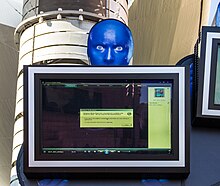Architecture of Las Vegas
Interest in the Architecture of
Initial thesis
In the 1970s, Venturi et al. observed that the city had then been structured around the
1990s revision

In the 1990s, Venturi and Scott Brown observed that the automotive-driven architecture of the 1960s had been transformed into a more pedestrianized form, in part as a result of the growth in visitors that it had experienced over the years.
Taylor also observed the replacement of neon with the televisual, to create a vast visual space in which "the virtual becomes real and the real becomes virtual".
References
Cross-reference
- ^ a b c Jaschke & Ötsch 2003, p. 7.
- ^ Hoeveler 2004, p. 89.
- ^ a b c d e f McGuigan 2006, p. 22.
- ^ Hoeveler 2004, p. 91.
- ^ a b c McGuigan 2006, p. 23.
- ^ McGuigan 2006, pp. 22–23.
- ^ a b Stierli 2013, p. 282.
- ^ a b Taylor 1998, p. 200.
- ^ a b Taylor 1998, p. 202.
Sources used
- Jaschke, Karin; Ötsch, Silke, eds. (2003). Stripping Las Vegas: A Contextual Review of Casino Resort Architecture. El verso. Vol. 7. Verl.d. Bauhaus-Universität. ISBN 9783860681923.
- Hoeveler, J. David, Jr. (2004). The Postmodernist Turn: American Thought and Culture in the 1970s. Rowman & Littlefield. ISBN 9780742533936.)
{{cite book}}: CS1 maint: multiple names: authors list (link - McGuigan, Jim (2006). Modernity And Postmodern Culture. Issues in cultural and media studies. McGraw-Hill Education. ISBN 9780335219216.
- Stierli, Martino (2013). Las Vegas in the Rearview Mirror: The City in Theory, Photography, and Film. Getty Publications. ISBN 9781606061374.
- ISBN 9781568981208.
Further reading
- Leach, Neil (1999). "The Architecture of the Catwalk". The Anaesthetics of Architecture. MIT Press. ISBN 9780262621267.
- Hess, Alan; ISBN 9780811801119.
- ISBN 9780262720298.
- Zook, Lynn M.; Sandquist, Allen; Burke, Carey (2009). "Roadside Architecture". Las Vegas, 1905–1965. Postcard history series. Arcadia Publishing. ISBN 9780738569697.
- ISBN 9780262720069.
- Chaplin, Sarah (2000). "Heterotopia desertia: Las Vegas and other spaces". In Borden, Iain; Rendell, Jane (eds.). Intersections: Architectural Histories and Critical Theories. Psychology Press. ISBN 9780415232920.
